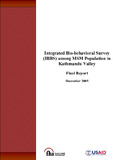Please use this identifier to cite or link to this item:
https://hdl.handle.net/20.500.14356/711Full metadata record
| DC Field | Value | Language |
|---|---|---|
| dc.contributor.author | Family Health International | |
| dc.contributor.author | Center for Research on Environment Health and Population Activities (CREHPA) | |
| dc.date.accessioned | 2013-02-25T20:00:46Z | |
| dc.date.accessioned | 2022-11-08T10:18:49Z | - |
| dc.date.available | 2013-02-25T20:00:46Z | |
| dc.date.available | 2022-11-08T10:18:49Z | - |
| dc.date.issued | 2005 | |
| dc.identifier.uri | http://103.69.126.140:8080/handle/20.500.14356/711 | - |
| dc.description.abstract | Introduction: In Asia, new HIV infections are growing rapidly even though sub-Saharan Africa remains the region with the greatest HIV prevalence. Of the 4.8 million new HIV infections worldwide, Asia accounted for 25%. The diverse cultures, economies, and demographic trends of Asian countries continue to pose challenges to programs aimed at controlling the raid spread of the virus. UNAIDS estimates that more than 7 million Asians are living with HIV, and that high-risk behaviors are fuelling the spread of the HIV (Thompson, 2005). Nepal is currently experiencing a concentrated HIV/AIDS epidemic among selected high-risk population, majority of whom comprised of young adults (15-29 years). Most of those living with the virus became affected while injecting drugs with used or infected needles or while buying or selling sex without using condoms. According to the National Center for AIDS and STD Control (NCASC) of the Ministry of Health and Population, as of July 31, 2005, there were5201 identified HIV positives cases in the country out of which 3790 were males and 1411 were females. Young adults (15-29 years of age) comprised 53% of the total identified HIV positive cases. Report on the global AIDS 2004 (UNAIDS) states that there are as many as 61,000 people living with HIV/AIDS by the end of 2003 in Nepal. The vulnerability for rapid transmission of HIV/AIDS in Nepal has increased many folds by pervasive poverty coupled with low literacy, gender inequality, labor migration, girls trafficking and increasing sex trade. The current conflict has further exasperated vulnerability resulting into massive labor migration broken family and social structure, loss of income and access to productive assets. However, understanding of different sexual networks in the general population in Nepal is limited and impedes HIV control. Most attention to date has been focused on heterosexual transmission of HIV. STIs infections are also commonly reported among the male population, particularly among migrant males (Garget al., 2001; Poudel et al., 2003). However, understanding of different sexual networks in the general population in Nepal is limited and impedes HIV control (Furber et al., 2002). | en_US |
| dc.language.iso | en_US | en_US |
| dc.subject | Integrated Bio-behavioral Survey (IBBS) among MSM Population in Kathmandu Valley | en_US |
| dc.title | Integrated Bio-behavioral Survey (IBBS) among MSM Population in Kathmandu Valley | en_US |
| dc.type | Technical Report | en_US |
| Appears in Collections: | Post Graduate Grant (PG) Reports | |
Files in This Item:
| File | Description | Size | Format | |
|---|---|---|---|---|
| IBBS_MSM_Final - Nov2004.pdf | Full Report. Download | 582.97 kB | Adobe PDF |  View/Open |
Items in DSpace are protected by copyright, with all rights reserved, unless otherwise indicated.
